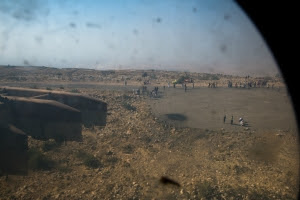An alternative non-US, non-journalist view of US Special Forces operations on Mount Sinjar. Read the whole report at the link below.
Rescued from Mount Sinjar

A refugee on Mount Sinjar tries to board a helicopter minutes before it crashed during an attempted take-off. (ADAM MIRANI)
ERBIL - Adam Mirani flew to Mount Sinjar on a mission that was supposed to be quick and straightforward: drop off food and water for some of the thousands of refugees stranded there, and return to Iraqi Kurdistan.
In the ensuing day and a half, however, Mirani would not only survive a deadly helicopter crash, but he would also meet some of the American Special Forces soldiers - as well as Syrian Kurdish militants from the People's Protection Units (YPG) - who were helping a handful of Kurdish Peshmerga soldiers protect civilians from the radical Islamist militants surrounding the mountain.
Mirani's Kurdish-Canadian family had helped provide a cargo of high-energy biscuits, dates, bread, and water, which were loaded onto an Iraqi Army helicopter bound for Mount Sinjar on Aug. 12. Mirani was one of the 14 people on board who flew out to distribute the supplies to members of Iraq's Yezidi minority, dozens of whom had already died of dehydration and hunger.
Two weeks ago, hundreds of thousands of Yezidis fled from the nearby city of Sinjar and other towns, after extremist militants from the so-called Islamic State (formerly the Islamic State of Iraq and al-Sham, or ISIS) launched an offensive in northern Iraq and seized several cities from Kurdish security forces. The offensive was so swift and deadly that it prompted U.S. President Barack Obama to authorize air strikes against ISIS fighters threatening Iraq's major cities and Yezidi refugees.

Pilots, journalists, and aid workers board a helicopter bound for Mount Sinjar on Aug. 12, 2014. (ADAM MIRANI)
After the helicopter landed, dozens of refugees swarmed around, desperate to be saved from the militants below and the withering desert heat on the mountain. As the humanitarian team unloaded the supplies, refugees climbed aboard, and Mirani estimates a total of between 30 and 40 people were on the helicopter when it was ready to lift off.
"The pilots obviously didn't want this many people on the aircraft, so one of the gunners went to the back and they really had to drag people off the helicopter because they knew there were too many," Mirani said. "Many people were screaming to let them stay. But you cannot hear people screaming because it's so loud."
The added weight made a complicated takeoff even more perilous. The mountain embankments all around made it hard to maneuver, and the threat of ISIS firepower below meant the pilot needed to take off fast. As the helicopter left the ground, it began to buck the pilot's efforts to control it.
"It hit the ground, scraped the bottom and probably took off the tires," Mirani said.
Then the nose of the chopper caught on the ground and the whole thing flipped, like a bicycle hitting only its front brake.

Refugees gather around a landing area awaiting an Iraqi Army helicopter carrying food and water. (ADAM MIRANI)
"We flipped twice, I believe, and landed front side up and on our side," Mirani said. "Everyone inside was thrown to the front of the aircraft, including me."
Next thing he knew, Mirani was caught in a tangle of bodies and limbs. He was being choked by his camera strap, with his camera wedged between several other people. His leg was also caught, and could only be freed after he ripped his pant leg and wriggled his foot from his shoe.
Continued at the link below)
No comments:
Post a Comment